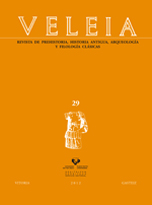Aurochs, Genetics, Indigenous People and Colonists: Apropos of the Neolithization of Europe
##plugins.themes.bootstrap3.article.main##
##plugins.themes.bootstrap3.article.sidebar##
Abstract
The mt-DNA analysis of auroch (Bos primigenius) bones from the site of Mendandia (Treviño), has produced a surprising result: one of the specimens has been identified with the genetic haplotype T3, the most common in European domestic cattle and generally considered unique (and indicative) of domestic livestock (Bos taurus). The direct radiocarbon dating of the sample (7265 ± 70 BP; Ua 34366) is consistent with the older Neolithic age of the level that yielded the sample (Level III-superior). This result is an opportunity to think about the process of Neolitization and enter into the debate about the role that may correspond to the indigenous people and immigrants. We evaluate the latest information on population genetics from the beginning of the Holocene as well as the average extension throughout Europe of early Neolithic settlements and lifestyle. The discussion leads us to believe that we are facing a very complex cultural phenomenon.
Downloads
##plugins.themes.bootstrap3.article.details##
Unless otherwise noted, the contents of the electronic edition of the OJS platform are licensed for use and distribution under a Creative Commons Attribution-NonCommercial-NoDerivatives 4.0 International (CC-BY-NC-ND) license.
The journal does not charge any financial compensation to authors for publishing in it and provides full access to the archives without any kind of embargo from the day of electronic publication. This respects the national open access policy.
All originals published in the journal Veleia, whether in print or digital format, are the property of the University of the Basque Country (UPV/EHU). © UPV/EHU
Authors of articles (whether research articles, news articles, news items or reviews) will be able to access their own work on the Journal's website. Authors will be able to put them in their personal repositories and will also have the possibility of pre-print dissemination of articles accepted for publication.

